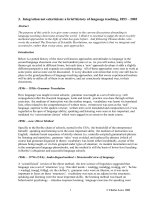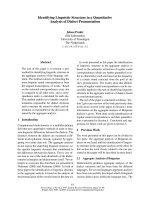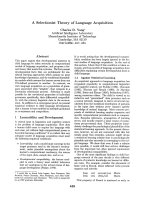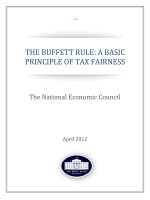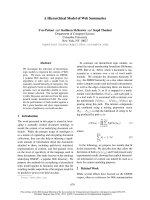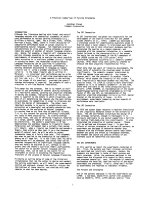A Component Unit of the State of Montana Consolidated Statements of Net Assets_part4 docx
Bạn đang xem bản rút gọn của tài liệu. Xem và tải ngay bản đầy đủ của tài liệu tại đây (336.28 KB, 10 trang )
Notes to the Consolidated Financial Statements (continued)
x Non-operating revenues - Non-operating revenues include activities that have the characteristics of
non-exchange transactions, such as gifts and contributions, and other revenue sources that are defined as
non-operating revenues by GASB No. 9, “Reporting Cash Flows of Proprietary and Nonexpendable
Trust Funds and Governmental Entities That Use Proprietary Fund Accounting,” and GASB No. 34,
“Basic Financial Statements and Management Discussion and Analysis for State and Local
Governments.” Types of revenue sources that fall into this classification are state appropriations and
investment income.
USE OF RESTRICTED REVENUES
When the University maintains both restricted and unrestricted funds for the same purpose, the order of use of such
funds is determined on a case-by-case basis. Restricted funds remain classified as restricted until they have been
expended.
SCHOLARSHIP DISCOUNTS AND ALLOWANCES
Student tuition and fee revenues, and certain other revenues from students, are reported net of scholarship discounts
and allowances in the Statements of Revenues, Expenses, and Changes in Net Assets. Scholarship discounts and
allowances are generated by the difference between the stated charge for goods and services provided by the
University, and the amount that is paid by students and/or third parties making payments on the students’ behalf.
Certain governmental grants, such as Pell grants, and other federal, state or nongovernmental programs, are recorded
as either operating or non-operating revenues in the University’s consolidated financial statements. To the extent that
revenues from such programs are used to satisfy tuition and fees and other student charges, the University has
recorded a scholarship discount and allowance.
x RECLASSIFICATION AND RESTATEMENT
In order to make certain prior year amounts compare to the current year presentation on the Consolidated Statement
of Net Assets, $1,901,335 was reclassified from accounts and grants receivable to due from federal government. On
the Consolidated Statement of Revenues, Expenses and Changes in Net Assets, certain prior year revenue amounts
were reclassified to more appropriate financial statement classifications, the largest was a $1,413,760 reclassification
from other operating revenues to tuition and fees.
NOTE 3 – CASH DEPOSITS, CASH EQUIVALENTS AND INVESTMENTS
CASH DEPOSITS
The University must comply with State statutes, which generally require that cash remain on deposit with the State
treasury, and as such are subject to the State’s investment policies. Certain exceptions exist, which allow funds to be
placed on deposit with trustees to satisfy bond covenants or to maximize investment earnings by placing certain
funds with University foundations. Deposits with State treasury and other financial institutions at June 30, 2008 and
2007 totaled $27,104,868 and $29,411,486, respectively
CASH EQUIVALENTS
Cash equivalents consist of $8,588,579 of cash invested in a money market fund with First American Funds, and
$18,126,404 in the STIP with the Montana Board of Investments. Amounts held in cash equivalents at June 30,
2008 and 2007 were $26,714,983 and $57,006,960, respectively. At June 30, 2008, $5,329,075 of the amount
invested in a money market fund, were unexpended proceeds from the issuance of Facility Improvement Revenue
Bonds. STIP investments are purchased in accordance with the statutorily mandated "Prudent Expert Principle.”
The STIP portfolio may include asset-backed securities, commercial paper, corporate and government securities,
repurchase agreements and variable rate, or floating rate, instruments to provide diversification and a competitive
rate of return. The First American Funds, Treasury Obligations Money Market Fund invests exclusively in short-
term U.S. Treasury Obligations, including repurchase agreements secured by U.S. Treasury Obligations. The U.S.
Treasury obligations in which the fund invests include U.S. Treasury bonds, notes and bills. Investments in STIP
and the money market fund may be withdrawn by the University on demand, and as such, are classified as cash
equivalents.
A-23
This is trial version
www.adultpdf.com
Notes to the Consolidated Financial Statements (continued)
INVESTMENTS
Investments consisted of the following at June 30, 2008 and 2007:
Fair Value
Effective
Duration at
June 30, 2008*
Credit Quality
Rating at June
30, 2008***
Security Type 2008 2007
U.S. Government Sponsored Entities $ 14,989,237 $ 2,056,148 2.635 AAA
Short Term Investment Pool (STIP)**** 1,866,274 - Not Applicable NR
Trust Fund Bond Pool (TFBP) 13,644,676 5,727,734 4.66** NR
Montana Domestic Equity Pool (MDEP) 1,140,294 1,318,308 Not Applicable N/A
Foundation Pooled Investments 15,980,210 17,802,727 Not Applicable N/A
Certificates of Deposits 283,871 270,530 .947 N/A
Total investments
$ 47,904,562 $ 27,175,447
Securities Lending Collateral Investment
Pool
$ 1,775,795 $ 317,923
*See Interest Rate Risk under the Investment Risks disclosure included in this note.
**Effective duration for the Trust Fund Bond Pool (TFBP) is for the entire portfolio. The University’s ownership
represents less than 0.5% of the portfolio
***NR indicates security investment unrated for credit quality type.
****Structured Investment Vehicle investments in STIP portfolio reclassified from cash and cash equivalents.
Investments held by the University at June 30, 2008 and 2007 are described further in the paragraphs below.
U.S. Government Sponsored Entities
U.S. government sponsored entities securities are mortgage-backed securities purchased and administered by the
Montana Board of Investments (MBOI), or bond trustee funds managed by U.S. Bank for the University. All of the
securities were registered under the nominee’s name (MBOI or U.S. Bank) on behalf of the University.
Montana Board of Investments Pools
The University is a participant in certain internal investment pools administered by the Montana Board of Investments
(MBOI). MBOI purchases investments for each portfolio in accordance with the statutorily mandated “Prudent
Expert Principle.” The University was invested in the following internal investment pools at June 30, 2008 and 2007:
Montana Domestic Equity Pool (MDEP
)
The MDEP portfolio may include common stock, equity index, preferred stock, convertible equity
securities, American Depositary Receipts (ADR’s) and equity derivatives. ADR’s are receipts issued by a
U.S. depositary bank representing shares of a foreign stock or bonds held abroad by the foreign sub-
custodian of the American depositary bank. Equity derivatives “derive” their value from other equity
instruments such as futures and options.
Trust Funds Bond Pool (TFBP)
The TFBP portfolio includes corporate asset-backed, other corporate, U.S. government mortgage-backed,
and Yankee securities. The TFBP portfolio includes securities classified as corporate, foreign government
bonds, municipals, U.S. government direct-backed, U.S. government indirect-backed, and cash equivalents.
U.S. government direct-backed securities include direct obligations of the U.S. Treasury and obligations
explicitly guaranteed by the U.S. government. U.S. government indirect-backed obligations include U.S.
government agency and mortgage-backed securities. U.S. government mortgage-backed securities reflect
participation in a pool of residential mortgages.
The TFBP portfolio includes structured financial instruments known as REMICs (Real Estate Mortgage
Investment Conduits). REMICs are pass-through vehicles for multiclass mortgage-backed securities.
A-24
This is trial version
www.adultpdf.com
Notes to the Consolidated Financial Statements (continued)
The University Foundation Pools
This pool consists of endowment funds held in a common investment pool administered by the University of
Montana and Montana Tech Foundations.
Certificates of deposit
Certificates of deposit serve as collateral for loans made to students with disabilities for the purchase of specialized
equipment necessary to complete their education. The certificate of deposit, including interest earned, is reinvested
upon maturity.
Securities lending transactions
Under the provisions of state statutes, the Board of Investments, via a Securities Lending Authorization Agreement,
has authorized the custodial bank, State Street Bank and Trust, to lend the Board of Investment’s securities to
broker-dealers and other entities with a simultaneous agreement to return the collateral for the same securities in the
future. During the period the securities are on loan, the Board of Investments receives a fee and the custodial bank
must initially receive collateral equal to 102 percent of the market value of the loaned securities and maintain
collateral equal to not less than 100 percent of the market value of the loaned security. The Board of Investments
retains all rights and risks of ownership during the loan period.
During the years ending June 30, 2008 and 2007, the Board of Investments and the borrowers maintained the right to
terminate all securities lending transactions on demand. The cash collateral received on each loan was invested,
together with the cash collateral of other qualified-plan lenders, in a collective investment pool, the Securities
Lending Quality Trust. The relationship between the average maturities of the investment pool and the Board of
Investment’s loans was affected by the maturities of the loans made by other plan entities that invested cash
collateral in the collective investment pool, which the Board of Investments could not determine. At June 30, 2008
and 2007, the Board of Investments had no credit risk exposure to borrowers.
Investment risks
Effective June 30, 2005, the University implemented the provisions of Governmental Accounting Standards Board
(GASB) Statement No. 40, “Deposit and Investment Risk Disclosures.” Investments administered by the MBOI for
the University are subject to their investment risk policies. The University does not have a formal investment policy
for interest rate risk or credit risk. Detailed asset maturity and other information demonstrating risk associated with
the State of Montana Board of Investments STIP and TFBP is contained in the State of Montana Board of
Investments financial statements, and may be accessed by contacting the Board of Investments at P.O. box 200126,
Helena, MT 59620-0126.
Investment risks associated with the University’s investments are described in the following paragraphs:
Interest Rate Risk
Interest rate risk is the risk that changes in interest rates will adversely affect the fair value of an investment.
According to GASB Statement No. 40, interest rate risk disclosures are not required for STIP since STIP is
a 2a-7-like pool. The TFBP investment policy does not formally address interest rate risk.
In accordance with GASB Statement No. 40, the State of Montana has selected the effective duration
method to disclose interest rate risk. Duration is a measure of a debt’s exposure to fair value changes from
changing interest rates. It uses the present value of the cash flows from the investment, weighting those
cash flows as a percentage of the investment’s full price.
Credit Risk
Credit risk is defined as the risk that an issuer or other counterparty to an investment will not fulfill its
obligation. With the exception of the U.S. government securities, all STIP securities and TFBP fixed
income instruments have credit risk as measured by major credit rating services. The Board of Investments’
policy requires that STIP securities have the highest investment grade rating in the short term category by at
least one Nationally Recognized Statistical Rating Organization (NRSRO). The First American money
market fund has received AAA credit quality ratings from three NSRO’s: Moody’s; Standard and Poor’s;
and Fitch.
A-25
This is trial version
www.adultpdf.com
Notes to the Consolidated Financial Statements (continued)
U.S. government securities are guaranteed directly or indirectly by the U.S. government. Obligations of the
U.S. government or obligations explicitly guaranteed by the U.S. government are not considered to have
credit risk and do not require disclosure of credit quality.
Custodial Credit Risk
Custodial credit risk for investments is the risk that, in the event of the failure of the counterparty to a
transaction, a government will not be able to recover the value of the investment or collateral securities
that are in the possession of an outside party. As of June 30, 2008 and 2007, all STIP, MDEP and TFBP
securities were registered in the nominee name for the MBOI and held in the possession of the Board’s
custodial bank, State Street Bank. According to the STIP Investment Policy, “repurchase agreements
require electronic delivery of U.S. Government Treasury collateral, priced at 102 percent market value, to
the designated State of Montana Federal Reserve Bank account.” The TFBP”s State Street repurchase
agreement was purchased in the State of Montana Board of Investments name.
Concentration of Credit Risk
Concentration of credit risk is the risk of loss attributed to the magnitude of a government’s investment in a
single issuer. Investments issued or explicitly guaranteed by the U.S. government are excluded from the
concentration of credit risk requirement. MDEP investments in pooled investments, such as the BGI Equity
Index and DFA Small Cap Subtrust investments, are also excluded from this requirement. According to the
TFBP Investment Policy, “with the exception of the U.S. government indirect-backed (agency) securities,
additional TFBP portfolio purchases will not be made if the credit risk exceeds 2 percent of the portfolio at
the time of purchase.” The concentration of credit risk exposure for U.S. government sponsored entities
securities held at June 30, 2008 and 2007, expressed as a percentage of total investments, was 31.29% and
7.57%, respectively.
Land grant earnings
In 1881, the Congress of the United States granted land to the State of Montana for the benefit of the state’s
universities and colleges. The Enabling Act of 1889 granted 46,563 acres to Missoula, 100,000 acres to Montana
Tech and 50,000 acres to Western Montana College. Under provisions of the grants, proceeds from the sale of land
and land assets, together with proceeds from the sale of timber, oil royalties and other minerals, must be reinvested,
and constitute, along with the balance of unsold land, a perpetual trust fund. The grant is administered as a trust by
the State Land Board, which holds title and has the authority to direct, control, lease, exchange and sell these lands.
The University, as a beneficiary, does not have title to the assets resulting from the grant, only a right to the earnings
generated. The University's share of the trust earnings was $1,616,632 and $1,505,512 for the years ended June 30,
2008 and 2007, respectively. These earnings are currently pledged to the Series C 1995, Series E 1998, Series F
1999, Series G 2002, Series I 2004, and Series J 2005 revenue bonds.
The University’s land grant assets are not reflected in the consolidated financial statements, but are included as a
component of the State of Montana Basic Financial Statements that are prepared annually and presented in the
Montana Comprehensive Annual Financial Report (CAFR).
NOTE 4 –SUBSEQUENT EVENT
The University of Montana invests funds with the Montana Board of Investments. A portion of the U.S
government sponsored entities securities held at June 30, 2008, were issued by the Federal National Mortgage
Association and the Federal Home Loan Mortgage Corp. The Federal National Mortgage Association (Fannie
Mae) and the Federal Home Loan Mortgage Corp. (Freddie Mac) were put into conservatorship on September 7,
2008.
A-26
This is trial version
www.adultpdf.com
Notes to the Consolidated Financial Statements (continued)
NOTE 5 – ACCOUNTS AND GRANTS RECEIVABLE
Accounts Receivable consisted of the following at June 30, 2008 and 2007:
2008 2007
Student tuition and fees $ 2,696,550 $ 1,460,483
Auxiliary enterprises and other operating activities 1,511,981 1,200,425
Private grants and contracts 229,316 622,524
Other 297,859 821,252
Gross accounts and grants receivable 4,735,706 4,104,684
Less: allowance for doubtful accounts 808,984 333,723
Nets accounts and grants receivable
$ 3,926,722 $ 3,770,961
NOTE 6 – LOANS RECEIVABLE
Student loans made under the Federal Perkins Loan Program constitute the majority of the University’s loan
receivable balances. Included in non-current liabilities as of June 30, 2008 and 2007 are $10,161,565 and
$10,020,616, respectively, that would be refundable to the Federal Government should the University choose to
cease participation in the Federal Perkins Loan program.
The Federal portion of interest income and loan program expenses is shown as additions to and deductions from
the amount due to the Federal government, and not as operating transactions, in the Consolidated Statement of
Net Assets.
NOTE 7 – INVENTORIES
Inventories consisted of the following at June 30, 2008 and 2007:
2008 2007
Bookstore $ 624,128 $ 709,927
Food services
123,247 117,814
Facilities services
716,815 697,431
Other
275,716 277,251
Total inventories
$ 1,739,906 $ 1,802,423
NOTE 8 – PREPAID EXPENSES AND DEFERRED CHARGES
Prepaid expenses and other deferred charges consisted of the following at June 30, 2008 and 2007:
2008 2007
Summer session $ 566,172 $ 568,285
Travel advances 49,732 55,101
Other prepaid expenses 2,125,477 1,882,050
Total prepaid expenses and other
deferred charges
$ 2,741,381 $ 2,505,436
A-27
This is trial version
www.adultpdf.com
Notes to the Consolidated Financial Statements (continued)
NOTE 9 – CAPITAL ASSETS
The following tables present the changes in capital assets for the years ended June 30, 2008 and 2007, respectively.
For the year ended June 30, 2008:
Beginning
Balance Additions Deletions
Transfers and
Other Changes Ending Balance
Capital assets not being
depreciated:
Land $ 7,125,781 $ 407,148 $ - $ - $ 7,532,929
Capitalized Collections 16,210,450 328,383 7,500 - 16,531,333
Construction in progress 52,028,936 32,209,652 - (37,051,480) 47,187,108
75,365,167 32,945,183 7,500 (37,051,480) 71,251,370
Other capital assets:
Buildings 204,142,766 260,056 52,000 33,590,973 237,941,795
Building improvements 129,972,955 1,174,017 51,232 3,326,703 134,422,443
Furniture and equipment 49,940,948 6,799,629 3,490,967 (787) 53,248,823
Land improvements 12,619,381 - - 133,804 12,753,185
Livestock 24,197 - 5,149 - 19,048
Library materials 50,920,432 1,413,464 120,035 - 52,213,861
447,620,679 9,647,166 3,719,383 37,050,693 490,599,155
Less accumulated
depreciation for:
Buildings 96,178,308 4,392,233 47,975 - 100,522,566
Building improvements 78,907,089 6,640,164 51,232 - 85,496,021
Furniture and equipment 31,833,236 3,873,635 3,348,960 - 32,357,911
Livestock 8,433 3,021 2,513 - 8,941
Land improvements 8,570,968 328,048 - - 8,899,016
Library materials 44,380,909 1,417,827 120,035 - 45,678,701
259,878,943 16,654,928 3,570,715 - 272,963,156
Other capital assets, net
187,741,736 (7,007,762) 148,668 37,050,693 217,635,999
Intangible assets
337,781 120,282 2,120 (156,819) 299,124
Total capital assets, net
$ 263,444,684 $ 26,057,703 $ 158,288 $ (157,606) $ 289,186,493
Capital Asset Summary:
Capital assets not
being depreciated $ 75,365,167 $ 32,945,183 $ 7,500
$ (37,051,480) $ 71,251,370
Other capital and
intangible assets
447,958,460 9,767,448 3,721,503 36,893,874 490,898,279
523,323,627 42,712,631 3,729,003 (157,606) 562,149,649
Less: accumulated
depreciation 259,878,943 16,654,928 3,570,715 - 272,963,156
Total capital assets, net
$ 263,444,684 $ 26,057,703 $ 158,288 $ (157,606) $ 289,186,493
A-28
This is trial version
www.adultpdf.com
For the year ended June 30, 2007:
Beginning
Balance Additions Deletions
Transfers and
Other Changes Ending Balance
Capital assets not being
depreciated:
Land $ 7,125,781 $ - $ - $ - $ 7,125,781
Capitalized Collections 15,461,417 779,533 30,500 - 16,210,450
Construction in progress 29,691,709 24,867,970 - (2,530,743) 52,028,936
52,278,907 25,647,503 30,500 (2,530,743) 75,365,167
Other capital assets:
Buildings 203,800,450 342,316 - - 204,142,766
Building improvements 127,504,476 - - 2,468,479 129,972,955
Furniture and equipment 46,344,468 4,609,591 959,950 (53,161) 49,940,948
Land improvements 12,619,381 - - - 12,619,381
Livestock
34,197 - 10,000 - 24,197
Library materials 49,289,112 1,633,880 - (2,560) 50,920,432
439,592,084 6,585,787 969,950 2,412,758 447,620,679
Less accumulated
depreciation for:
Buildings 91,680,684 4,497,624 - - 96,178,308
Building improvements 72,214,239 6,692,850 - - 78,907,089
Furniture and equipment 29,233,638 3,491,646 892,168 120 31,833,236
Livestock 7,685 3,165 2,417 - 8,433
Land improvements 8,220,918 350,050 - - 8,570,968
Library materials 42,744,327 1,560,137 - 76,445 44,380,909
244,101,491 16,595,472 894,585 76,565 259,878,943
Other capital assets, net
195,490,593 (10,009,685) 75,365 2,336,193 187,741,736
Intangible assets
502,879 82,000 205 (246,893) 337,781
Total capital assets, net
$ 248,272,379 $ 15,719,818 $ 106,070 $ (441,443) $ 263,444,684
Capital Asset Summary:
Capital assets not
being depreciated $ 52,278,907 $ 25,647,503 $ 30,500 $ (2,530,743) $ 75,365,167
Other capital and
intangible assets
440,094,963 6,667,787 970,155 2,165,865 447,958,460
492,373,870 32,315,290 1,000,655 (364,878) 523,323,627
Less: accumulated
depreciation 244,101,491 16,595,472 894,585 76,565 259,878,943
Total capital assets, net
$ 248,272,379 $ 15,719,818 $ 106,070 $ (441,443) $ 263,444,684
NOTE 10 – DEFERRED REVENUES
Deferred Revenues consisted of the following at June 30, 2008 and 2007:
2008 2007
Grant and contract revenue received in advance $ 5,049,108 $ 7,370,624
Summer session payments received in advance 3,127,622 3,001,289
Other deferred revenues 3,108,617 2,866,095
Total deferred revenue
$ 11,285,347 $ 13,238,008
A-29
This is trial version
www.adultpdf.com
Notes to the Consolidated Financial Statements (continued)
NOTE 11 – ACCOUNTS PAYABLE AND ACCRUED LIABILITIES
Accounts payable and accrued liabilities consisted of the following at June 30, 2008 and 2007:
2008 2007
Compensation, benefits and related liabilities $ 16,594,137 $ 9,901,594
Accrued interest expense 874,676 908,178
Accounts payable and other accrued liabilities 3,207,044 4,793,802
Total accounts payable and accrued liabilities
$ 20,675,857 $ 15,603,574
NOTE 12 – LONG–TERM LIABILITIES
The following tables present the changes in long-term liabilities for the years ended June 30, 2008 and 2007,
respectively:
For the year ended June 30, 2008:
Beginning
Balance Additions Deductions
Ending
Balance
Current
Portion
Bonds, notes and capital leases
Revenue bonds payable, net $ 145,121,397 $ 268,307 $ 5,659,681 $139,730,023 $ 5,590,000
Notes payable 930,491 232,589 416,976 746,104 85,188
Capital leases payable 431,137 425,635 220,290 636,482 242,548
146,483,025 926,531 6,296,947 141,112,609 5,917,736
Other long-term liabilities
Accrued compensated absences 20,390,110 9,537,369 8,544,289 21,383,190 8,856,934
Advances from primary government 5,466,477 110,404 390,115 5,186,766 408,382
Other Post Employment Benefits - 7,351,584 - 7,351,584 -
Due to Federal Government 10,020,616 140,949 - 10,161,565 -
Derivative financial instrument 2,094,500 - - 2,094,500 -
37,971,703 17,140,306 8,934,404 46,177,605 9,265,316
Total long-term liabilities
$ 184,454,728 $ 18,066,837 $ 15,231,351 $ 187,290,214 $ 15,183,052
For the year ended June 30, 2007:
Beginning
Balance Additions Deductions
Ending
Balance
Current
Portion
Bonds, notes and capital leases
Revenue bonds payable, net $ 150,007,775 $ 268,303 $ 5,154,681 $ 145,121,397 $ 5,610,000
Notes payable 1,590,964 - 660,473 930,491 418,470
Capital leases payable 636,037 32,866 237,766 431,137 151,404
152,234,776 301,169 6,052,920 146,483,025 6,179,874
Other long-term liabilities
Accrued compensated absences 19,359,552 9,118,942 8,088,384 20,390,110 8,290,619
Advances from primary government 5,841,295 - 374,818 5,466,477 390,118
Due to Federal Government 9,875,660 144,956 - 10,020,616 -
Derivative financial instrument 2,094,500 - - 2,094,500 -
37,171,007 9,263,898 8,463,202 37,971,703 8,680,737
Total long-term liabilities
$ 189,405,783 $ 9,565,067 $ 14,516,122 $ 184,454,728 $ 14,860,611
A-30
This is trial version
www.adultpdf.com
Notes to the Consolidated Financial Statements (continued)
Long-term liabilities include:
x capital lease obligations, principal amounts of bonds payable, revenue bonds payable, and notes payable with
contractual maturities greater than one year;
x estimated amounts for accrued compensated absences and other liabilities that will not be paid within the next
fiscal year; and
x other liabilities that, although payable within one year, are to be paid from funds that are classified as non-
current assets.
Interest Rate Exchange Agreement
In August, 2005 the University entered into a forward SWAP agreement (“swaption”) with Wachovia Bank, NA
(“counterparty”) to hedge the interest rate risk associated with the potential future issuance of variable-rate
revenue bonds. In exchange, the University received $2,094,500 from the counterparty. A portion of the
payment was consideration for the estimated present value of the fixed rate payable under the agreement upon
execution of the swaption. The swaption gives the counterparty the right to require that the University execute a
floating-to-fixed swap in May 2010, based on a notional amount of $47,000,000. Should the counterparty
exercise its option, the University would expect to issue Series K 2010 taxable, variable rate bonds at the
$47,000,000 notional amount of the swap. The intention of the University in entering into the swaption was to
refund its outstanding Series F 1999 Revenue Bonds and lower the cost of its borrowing.
Terms – The counterparty has the right to exercise the swap on May 15, 2010, the call date of the Series F 1999
Revenue Bonds. If the swaption is exercised it will also become effective on May 15, 2010. Under terms of the
swap, the University will pay the counterparty a fixed rate substantially equal to the fixed rate on the refunded
bonds and receive a variable payment based on the one-month LIBOR rate, plus 30 basis points.
Once the refunded Series F 1999 Revenue Bonds escrow matures in 2019, the floating rate Series K 2010 Parity
Bonds will be converted to tax-exempt bonds and the swap will convert to tax exempt rates as well. Should the
option to enter the swap not be exercised by the counterparty, the University would not be required to repay the
swaption purchase price.
Fair Value – At June 30, 2008, the swaption has a negative fair value of $2,309,206. Such value was provided to
the University by the counterparty, and was calculated as an approximation of market value derived from
proprietary models and from certain other financial information believed to be reliable by the counterparty. The
negative fair value of the swaption indicates that the fixed rate the University would pay under the potential
transaction exceeded the one-month London InterBank Offering Rate (LIBOR) at June 30, 2008.
Market-access risk – If the option is exercised and variable-rate Series K 2010 Parity Bonds are not issued by the
University, the Series F 1999 Revenue Bonds would not be refunded, and the University would make net swap
payments as required by the terms of the swap.
Capital Leases
The University has future minimum lease commitments for capital lease obligations consisting of the following at
June 30, 2008:
Fiscal Year Total
2009 $ 293,141
2010 231,425
2011 117,727
2012 73,178
2013 16,828
Minimum lease payments $ 732,299
Less: Amount representing interest 95,817
Present value of net minimum lease payments $ 636,482
A-31
This is trial version
www.adultpdf.com
Notes to the Consolidated Financial Statements (continued)
NOTE 13 – REVENUE BONDS
Revenue bonds were issued pursuant to an Indenture of Trust between the Board of Regents of Higher Education for
the State of Montana (on behalf of The University of Montana) and U. S. Bank Trust National Association MT. The
bonds are secured by a first lien on the combined pledged revenues of the four campuses of The University of
Montana. The pledged revenues earned at each campus are cross-pledged among all campuses of The University of
Montana. Bonds payable recorded by each campus reflect the liability associated with the bond proceeds deposited
into the accounts of that campus and do not necessarily mean that the debt service payments on that liability will be
made by that campus.
The total aggregate principal amount originally issued pursuant to the Indenture of Trust and the various
supplements to the Indenture for all campuses of The University of Montana at June 30, 2008 and 2007, was
$168,411,780 and $169,426,780, respectively. The combined principal amount outstanding at June 30, 2008 and
2007 was $141,954,997 and $147,564,997, respectively.
Series C 1995
On December 14, 1995, The University of Montana issued $34,406,784 of Series C 1995 Revenue Bonds, with
interest ranging from 3.80 percent to 5.75 percent. In fiscal year 2000, the Series F 1999 Revenue Bonds issuance
advance refunded a portion of Series C 1995 revenue bonds.
Series E 1998
On June 26, 1998, The University of Montana issued $10,670,000 of Series E 1998 Revenue Bonds, with interest
ranging from 3.90 percent to 5.00 percent. The proceeds from the issue provided funds for the acquisition,
construction, repair, replacement, renovation and improvement of certain facilities and properties.
Series F 1999
On November 12, 1999, The University of Montana issued $69,240,000 of Series F 1999 Revenue Bonds, with
interest rates ranging from 3.80 percent to 6.00 percent. The proceeds from the issue were used for the purpose of
restructuring Series B, C and D Facilities Improvement Revenue Bonds, and for the acquisition, construction,
remodeling, improvement and equipping certain facilities and properties at The University of Montana.
The University of Montana recorded $58,205,000 of the Series F 1999 Revenue Bonds to advance refund
$58,609,189 of outstanding Series B, C and D Facilities Improvements Revenue Bonds with average interest rates
ranging from 4.30 percent to 6.65 percent. The Series B, C and D Facilities Improvements Revenue Bonds are
considered legally defeased and as a result, the liability for those bonds is no longer recorded in the consolidated
financial statements.
Included in the Series F issuance was $10,650,000 for construction of a new recreation facility at the University’s
Missoula campus. In September, 2005, the Series J 2005 Revenue Bond issuance advanced refunded the
outstanding principal amount of this portion of the Series F 1999 issuance (see Series J 2005 below).
Series G 2002
On October 18, 2002, The University of Montana issued $18,900,000 of Series G Facilities Improvement Revenue
Bonds, with interest ranging from 3.00 percent to 4.65 percent. The proceeds from the issue provided funds for the
acquisition, construction, furnishing and equipping of certain student housing facilities on the Missoula campus.
Series I 2004
In April 2004, The University of Montana issued $40,490,000 of Series I Refunding and Facilities Improvement
Revenue Bonds, with interest ranging from 3.00 percent to 4.75 percent. The proceeds from the issue paid and
discharged $30,540,000 of Series A 1993, Revenue Bonds. The issuance also provided $7,000,000 towards future
expansion of the Skaggs Building and $2,950,000 for deferred maintenance on the Missoula campus.
Series J 2005
On September 15, 2005, The University of Montana issued $31,095,000 of Series J 2005 Facilities Improvement
and Refunding Revenue Bonds, with interest ranging from 3.0 percent to 4.5 percent. The proceeds from the
A-32
This is trial version
www.adultpdf.com
